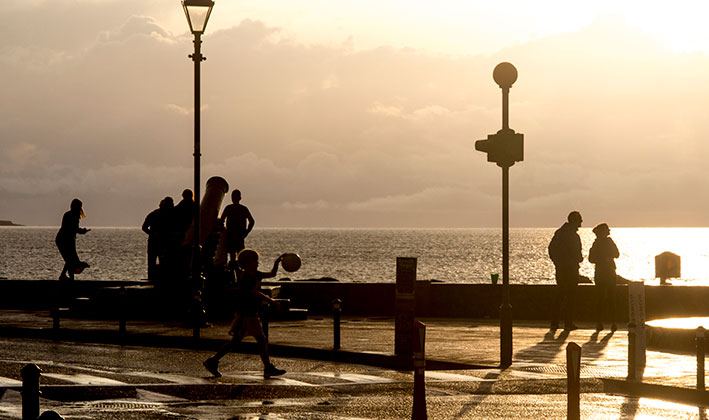The Coolera region was an important social and ritual centre in the Neolithic era, 5,000 years ago (4000–2500BC). At least 60 megalithic monuments are scattered throughout Coolera. On top of Knocknarea mountain sits the huge mound that is said to be the grave of Queen Maeve, a personification of the age-old goddess of landscape and sovereignty.
Ancient people have left their mark here; you will see passage tombs on top of Knocknarea, the Giant’s Grave, a Neolithic court tomb beside the Airport Road, an Early Medieval ringfort beside the school, the Early Christian graveyard and church at Killaspugbrone as well as old landlords’ houses, stone-walled wells and 19th-century thatched cottages.
Look up to Knocknarea and you will see where our ancestors farmed, left their dead in caves till their flesh decayed and built tombs to hold their remains. Carrowmore, to the east, is one of the largest groupings of Neolithic tombs in Europe.
The Yeats brothers, poet William and painter Jack, were inspired by all the beauty, folklore and history of Coolera.
Strandhill is mostly set in the townlands of Carrowbunnaun, Larass and Killaspugbrone. In 1749 the Census of Elphin recorded just one household, with two people, in Carrowbunnaun, while Larass had seven households and 26 people.
The first Strandhill village was located somewhere northeast of the airport runway but it was buried by blowing sand in the 19th century and people moved their homes to higher ground.
During the 1891 bye-election, the Irish national leader Charles Stuart Parnell rowed to Strandhill from Rosses Point via Coney Island to campaign. However, because he had married a divorced woman, Kitty O’Shea, shortly before, which caused a big scandal, he met a hostile reception and did not speak. He did dine at Glen Lodge house, in Culleenduff townland south of Strandhill.
In 1895, Belfast man Benjamin Murrow bought land and built a new road through Carrowbunnaun down to the shore to open it up as a seaside resort. He called his new road Buenos Ayres Drive and it is still the main road to the seafront. He opened seaweed baths and set up the cannon, bought from the Sligo Militia artillery battery at Rosses Point, on the shore where it stands today.
He was the first person in Coolera to register a motor car when, in 1904, he paid five shillings on his 12hp ‘Dainter’, registration EI 17. In 1920 he built a fine dwelling, surrounded by a castle-style wall, at the top of the road, which he called Buenos Ayres House.
The Atlantic Hotel was built by Michael Ballantine in 1910 opposite Benjamin Murrow’s house. Visitors started to come and gradually the small, scattered hamlets grew and joined up to form the present Strandhill.
The original road from Ballisodare to Sligo crossed the present-day golf course, ran past St Patrick’s church and down, parallel to the modern Airport Road, to the shore northeast of Killaspugbrone. The Burma Road, once a path called Thady’s Lane on the 19th-century estate of the Walker family of Rathcarrick, was built in 1945. St Patrick’s Catholic church was opened in 1921.
Carrowbunnaun, where Strandhill car park is now located, was wild sand dunes where farmers drove horse-drawn carts to the shore to gather seaweed for fertiliser over 100 years ago. Among the dunes are wild orchids and flowers in many colours.
Today you can relax in the silken water of a seaweed bath, stroll along the shore, surf, trek, enjoy fine food and explore this modern seaside village and the ancient Coolera peninsula.
FROM HERE YOU CAN:
- Walk around Knocknarea mountain and take the trail to the summit and Queen Maeve’s grave.
- Follow the Killaspugbrone Loop path from the seafront to Killaspugbrone Early Christian graveyard and church.
- Walk left at the seafront and follow the beach around Portcurry Point to wide-open Culleenamore beach.
Take happy memories with you but leave no litter and respect the ancient monuments. Watch out for other walkers and traffic












